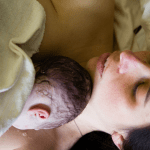Did you know that your beauty, sensuality, and sexuality is impaired by pheromone loss?
This is due to the skin and mucosal aging when you’re going through menopause, pheromone concentrations in the nasal and oral mucosa decreases with age with a specific loss during and after the menopause. Skin and mucosal aging is perceived as a critical impairing factor for a woman’s sexuality and sensuality.

The hormone loss in particular, estrogen, sun aging, and genetic factors all contribute to the increase of wrinkles and loss of all skin and mucosal components. These important skin and mucosal components include collagen. Collagen is that primary building block of your body’s skin, muscles, bones, tendons, and ligaments, and other connective tissues. It’s also found in your organs, blood vessels, and intestinal lining.
So you may have heard of elastin. Elastin is one of the most abundant proteins in your body. It’s the stretchy protein that resembles a rubber band and it can stretch out and extend and shrink back or recoil. And this is a major component of tissue in your body that requires stretchiness, like your lungs, bladder, large blood vessels, some ligaments, and your skin.
Then there’s other components as well. Mucopolysaccharides, which are long chains of sugar molecules that are found throughout the body, often in the mucus and fluid around the joints. Then there is the sebaceous secretion. A sebaceous gland is an exocrine gland in the skin that opens into a hair follicle to secrete an oily or waxy matter called sebum.

And then there’s pheromones, which I’ve mentioned. Skin aging and pheromone loss may dramatically impact on, and this is unconsciously, your sexual attractiveness.
So what can you do? HRT or hormone replacement therapy or bioidentical hormone therapy may partially stimulate the secretion of pheromones. And the sooner you start that, the better.
And the HRT can also help reduce the negative effects of menopause on sexual attraction and help women and couples to maintain a stronger attractiveness which is mediated by their pheromones. And this also further enhances the dynamics of pair bonding.







